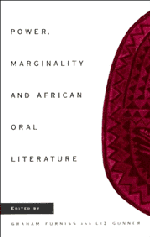Book contents
- Frontmatter
- Contents
- List of contributors
- Preface
- Note on transcription
- 1 Introduction: power, marginality and oral literature
- Part I Orality and the power of the state
- Part II Representing power relations
- Part III Oral forms and the dynamics of power
- 8 Power, marginality and Somali oral poetry: case studies in the dynamics of tradition
- 9 The function of oral art in the regulation of social power in Dyula society
- 10 The power of words and the relation between Hausa genres
- Part IV Endorsing or subverting the paradigms: women and oral forms
- Part V Mediators and communicative strategies
- Bibliography
- Index
8 - Power, marginality and Somali oral poetry: case studies in the dynamics of tradition
Published online by Cambridge University Press: 18 December 2009
- Frontmatter
- Contents
- List of contributors
- Preface
- Note on transcription
- 1 Introduction: power, marginality and oral literature
- Part I Orality and the power of the state
- Part II Representing power relations
- Part III Oral forms and the dynamics of power
- 8 Power, marginality and Somali oral poetry: case studies in the dynamics of tradition
- 9 The function of oral art in the regulation of social power in Dyula society
- 10 The power of words and the relation between Hausa genres
- Part IV Endorsing or subverting the paradigms: women and oral forms
- Part V Mediators and communicative strategies
- Bibliography
- Index
Summary
The performance of Somali oral poetry on the Horn of Africa is not limited to formal presentations to defined audiences. Many instances of the performance of verse occur in non-formal situations, often overlooked and considered culturally insignificant by scholars of the past, who have concentrated their efforts on the highly prestigious classical genres used to debate political and social issues overtly in this East African, Cushitic society. Among the powerful, which means for the most part, elder men, work songs are considered to be of low prestige, and thus study and analysis of them has been neglected by scholars, both Somali and foreign alike. In so doing, a large body of traditional lore has been overlooked, both from the point of view of aesthetics and of social interaction in very interesting contexts. Moreover, the most recent genre to develop in Somalia, called hees or heello, began its career with low prestige, because it, too, was the voice of marginal segments of the society. As an urban-based genre, heellooyin have always been composed and recited by the youth of the country and even by women. In fact, it was with this genre that public performances by women became socially acceptable.
This chapter describes some common situations of work and illustrates how poetry is employed as an act of communication and even defiance between individuals and groups which are marginal in the power structure of Somalia and those who hold power in that country.
- Type
- Chapter
- Information
- Power, Marginality and African Oral Literature , pp. 111 - 121Publisher: Cambridge University PressPrint publication year: 1995
- 4
- Cited by



